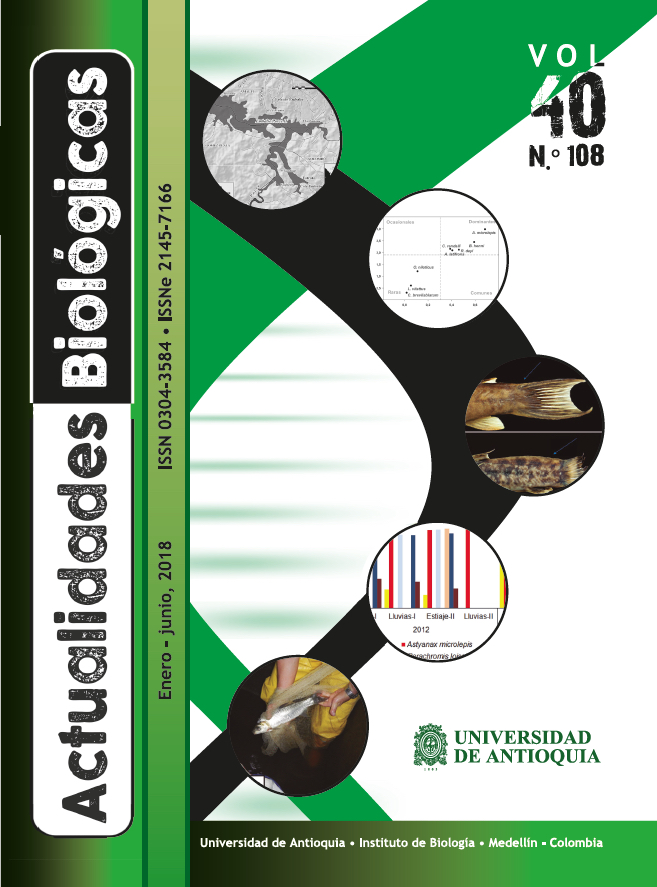Fish inside the discharge tunnels of a hydropower facility in the Porce River
DOI:
https://doi.org/10.17533/udea.acbi.v40n108a09Keywords:
tropics, Andean river, hydropower, freshwater migratory fish, management strategyAbstract
Flow in discharge tunnels of hydropower plants stimulates the entrance of potamodromous fish into these structures since the dam acts as a barrier to migration. Rescue of fish in the discharge tunnel is a management strategy to reduce the probability of entrapment inside the tunnels. At the Porce III hydropower station, the presence of the fish is detected when the discharge tunnel of the Porce III plant is emptied to perform maintenance activities to the discharge gates of the generation units. In the years 2012, 2013 and 2015 the trapped fish were transported from the discharge tunnels to the channel of the Porce River, downstream of the dam. Eight species of fish were found, different from those reported in other similar structures. In the transfers, individuals of migratory species were predominant. Those species move two times by year from the lowlands of the basin to the different tributaries. This mitigation strategy has been favorable to avoid fish mortalities due to their entrapment within these structures during their maintenance and it has been frequently adopted as a management activity by hydropower companies.
Downloads
References
Buckup PA. 1992. Redescription of Characidium fasciatum, Type Species of the Characidiinae (Teleostei, Characiformes). Copeia 4: 1066-1073.
Carvajal-Quintero JD, Escobar F, Alvarado F, Villa-Navarro FA, Jaramillo-Villa U, Maldonado-Ocampo JA. 2015. Variation in freshwater fish assemblages along a regional elevation gradient in the northern Andes, Colombia. Ecology and Evolution, 5(13): 2608–2620. DOI:10.1002/ece3.1539
Dahl G. 1971. Los peces del Norte de Colombia. Bogotá: Instituto de
Desarrollo de los Recursos Naturales Renovables (INDERENA, Ministerio de Agricultura).
Eschmeyer WNR, Fong JD. 2017. Catalog of fishes. San Francisco (CA): California Academy of Sciences; [fecha de acceso julio 10, 2017].http://researcharchive.calacademy.org/research/ichthyology/catalog/speciesbyfamily.asp
Jaramillo-Villa U, Maldonado-Ocampo JA, Escobar F. 2010. Altitudinal variation in fish assemblage diversity in streams of the central Andes of Colombia. Journal of Fish Biology, 76: 2401–2417. DOI:10.1111/j.1095-8649.2010.02629.x
Javahery S, Nekoubin H, Moradlu AH. 2012. Effect of anesthesia with clove oil in fish (review). Fish Physiology and Biochemistry, 38(6): 1545-1552. DOI: 10.1007/s10695-012-9682-5
Jiménez-Segura LF, Palacio J, Leite R. 2010. River flooding and reproduction of migratory fish species in the Magdalena River Basin, Colombia. Ecology of Freshwater Fish, 19(2): 178–186. DOI:10.1111/j.1600-0633.2009.00402.x
Jiménez-Segura LF, Álvarez-León R, Gutiérrez-Bonilla F, Hernández S, Valderrama M, Villa-Navarro F. 2011. La pesca y los recursos pesqueros en los embalses colombianos. En: CA Lasso, F Gutiérrez, M Morales-Betancourt, E Agudelo, H Ramírez-Gil, RE Ajiaco-Martínez editores. II. Pesquerías continentales de Colombia: cuencas del Magdalena- Cauca, Sinú, Canalete, Atrato, Orinoco, Amazonas y vertiente del Pacífico. Serie Editorial Recursos Hidrobiológicos y
Pesqueros Continentales de Colombia. Bogotá: Instituto de Investigación de Recursos Biológicos Alexander von Humboldt. p. 233-281.
Jiménez-Segura LF, Álvarez J, Ochoa LO, Loaiza A, Londoño JP, Restrepo-Santamaria D, Aguirre K, Hernández A, Correa JD, Jaramillo-Villa U. 2014. Guía Ilustrada Peces Cañón del río Porce, Antioquia. Medellín: Empresas Públicas de Medellín-Universidad de Antioquia.
Jiménez-Segura LF, Restrepo-Santamaría D, López-Casas S, Delgado J, Valderrama M, Álvarez J, Gómez D. 2014. Ictiofauna y desarrollo del sector hidroeléctrico en la cuenca del río Magdalena – Cauca, Colombia. Biota Colombiana, 15(2): 3–25. http://dx.doi.org/10.21068/bc.v15i2.317
Jiménez-Segura LF, Galvis-Vergara G, Cala-Cala P, García-Alzate CG, López-Casas S, Ríos-Pulgarín MI, Arango GA, Mancera-Rodríguez N, Gutiérrez-Bonilla F, Álvarez-León R. 2016. Freshwater fish faunas, habitats and conservation challenges in the Caribbean river basins of north-western South America. Journal of Fish Biology, 89(1): 65–101. DOI: 10.1111/jfb.13018
Landínez-García RM, Márquez LJ. 2016. Development and characterization of 24 polymorphic microsatellite loci for the freshwater fish Ichthyoelephas longirostris (Characiformes: Prochilodontidae). PeerJ 4:e2419. https://doi.org/10.7717/peerj.2419
López-Casas S, Jiménez-Segura LF, Pérez-Gallego CM. 2014. Peces migratorios al interior de una central hidroeléctrica: caso Miel I, cuenca del río Magdalena (Caldas-Antioquia), Colombia. Biota Colombiana, 15(2): 26- 39.http://hdl.handle.net/20.500.11761/9453
López-Casas S, Jiménez-Segura LF, Agostinho AA, Pérez-Gallego CM. 2016. Potamodromous migrations in the Magdalena River basin: bimodal reproductive patterns in neotropical rivers. Journal of Fish Biology, 89(1): 157-71. DOI: 10.1111/jfb.12941
Maldonado-Ocampo JA, Ortega-Lara A, Usma JS, Galvis G, Villa-Navarro FA, Vásquez L, Prada-Pedreros S, Ardila C. 2005. Peces de los Andes de Colombia. Bogotá (Colombia): Instituto de Investigación de Recursos Biológicos Alexander von Humboldt.
Usma-Oviedo S, Villa-Navarro F, Lasso CA, Castro F, Zuñiga PT, Cipamocha CA, Ortega-Lara A, Ajiaco RE, Ramírez-Gil H, Jiménez-Segura LF, Maldonado-Ocampo JA, Muñoz J, Suarez JT. 2013. Peces Dulceacuícolas Migratorios. En: Zapata IA, Usma JS editores. Guía de las especies migratorias de la biodiversidad en Colombia, Vol. 2. Bogotá: Ministerio de Ambiente y Desarrollo Sostenible. WWF-Colombia. p. 216–485.
Published
How to Cite
Issue
Section
License
Copyright (c) 2018 Actualidades Biológicas

This work is licensed under a Creative Commons Attribution-NonCommercial-ShareAlike 4.0 International License.
The authors exclusively authorize the Actualidades Biológicas journal to edit and publish the submitted manuscript if its publication is recommended and accepted, without this representing any cost to the Journal or the University of Antioquia.
All the ideas and opinions contained in the articles are sole responsibility of the authors. The total content of the issues or supplements of the journal is protected under the Creative Commons Attribution-NonCommercial-ShareAlike 4.0 International License, so they cannot be used for commercial purposes, but for educational purposes. However, please mention the Actualidades Biológicas journal as a source and send a copy of the publication in which the content was reproduced.












